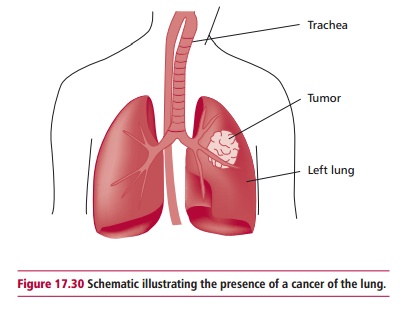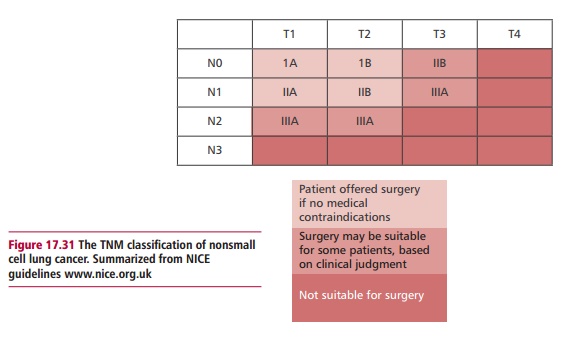Chapter: Biology of Disease: Cancer
Lung Cancer: Classification, Treatment, Signs, symptoms, diagnosis and staging

LUNG CANCER
Almost 29 000 deaths were attributed to lung cancer (Figure 17.30) in England and Wales in 2002 and around 37 000 new cases are diagnosed annually. In the USA lung cancer is, again, the second most common malignancy after prostate cancer in men and breast cancer in women, with over 160 000 new cases occurring each year. Worldwide, about one million new cases occur annually, with an incidence of 37.5 new cases per million population amongst men, and 10.8 cases per million amongst women.

Lung cancer is a fatal disease and, in England and Wales, only approximately 20% and 6.0% of patients survive one year and five years respectively after diagnosis. These figures are higher in the USA, where the five-year survival figure stands at about 14%. Overall, lung cancer is the most frequent cause of death from cancer in men, who make up around 60% of all lung cancer cases. In women, lung cancer is the second commonest cause of cancer death after breast cancer. The risk of lung cancer increases with age with approximately 75% of deaths occurring after the age of 65.
A link between smoking and cancer is indisputable and smoking and passive smoking are the cause of 90% of lung cancers. The carcinogens in cigarette smoke include benzo[a]pyrene, a polycyclic hydrocarbon and N-nitrosamines, both of which are metabolized by the cytochrome P-450 enzymes in the liver to carcinogens that form adducts with DNA as described. Radon, a naturally occurring radioactive gas produced from the decay ofuranium and which is found at relatively high indoor levels in homes built of, and on, granite, is also responsible for a small but statistically significant number of cases each year. People who work in uranium mines are also at risk of radon-induced lung cancer. Exposure to the mineral asbestos is also strongly associated with the development of lung cancer and increases the risk of developing lung cancer fivefold.
Classification of lung cancer
Lung cancer is classified into two main groups namely small cell lung carcinoma (SCLC) and nonsmall cell lung carcinoma (NSCLC). Small cell lung carcinoma accounts for about 20% of all lung cancers. The cancer cells are small with a high nucleus to cytoplasm ratio. Nonsmall cell lung carcinomas are comprised of three types, namely squamous cell carcinoma, adenocarcinoma and large cell carcinoma. Squamous cell carcinomas develops from the epithelial cells lining the respiratory tract; they form 35% of all lung cancers. Adenocarcinomas develop from the mucus-secreting cells in the lining of the respiratory tract and account for 27% of lung cancers. Finally, large cell carcinoma, so called because the cells are relatively large and rounded compared with the other forms, accounts for 10% of total lung cancers.
Signs, symptoms, diagnosis and staging of lung cancer
Lung cancer does not generally cause symptoms in the early stages and by the time these occur the disease is generally in an advanced state. Some patients are asymptomatic and may only be diagnosed following a routine chest X-ray. Symptoms at presentation include a persistent and nagging cough, shortness of breath, recurrent chest infections such as pneumonia and bronchitis, coughing up blood-containing sputum or hemoptysis, chest pain when breathing or coughing, and an unexplained loss of weight. A patient showing these symptoms should be referred urgently for a chest X-ray and/or a CT scan. If these indicate cancer, the tumor should be staged by scanning patients using positron emission tomography (PET). Other tests include examination of the chest by inserting an endoscope through a small cut at the base of the neck. In addition, biopsy may be taken using a fine needle inserted into the lungs, guided by a CT scanner or X-ray machine.
Staging of the disease is required to determine treatment. The TNM staging system, mentioned, for NSCLC classifies the primary tumor from T1 to T4, where T1 represents a tumor less than 3 cm diameter with no invasion of the main bronchus. Tumors greater than 3 cm that may also involve the main bronchus are classified as T2, while T3 represents a tumor of any size which has invaded the chest wall, diaphragm, mediastinal pleura, parietal pericardium or main bronchus. A T4 stage tumor is one of any size that has invaded any of a range of tissues, such as the heart, trachea or esophagus. The regional lymph nodes are staged as N0 to N3, where N0 represents no regional lymph node metastasis, N1 and N2 represents increasing metastasis to lymph nodes on the same side or opposite side to the tumor respectively. Where distant metastasis has occurred, this is classified as M1. The TNM is further classified into subsets as shown in Figure 17.31.

The staging for SCLC is somewhat different with patients being classified as having limited stage disease or extensive stage disease. Limited stage disease is used if the tumor is restricted to one hemithorax and may include patients with lymph node metastasis. Extensive disease is defined as disease at sites beyond the definition of limited disease.
Treatment of lung cancer
For NSCLC, surgery is used to remove the tumor, as directed by the staging. How much of the lung is removed depends on the stage of disease and the health
During surgery, lymph nodes are sampled to aid more accurate staging of disease. Radiotherapy is recommended for patients with stage I, II or III disease. Patients with Stage III or IV may be offered chemotherapy although NSCLC is only moderately sensitive to chemotherapy. Chemotherapy for advanced NSCLC uses a combination of drugs such as paclitaxel or docetaxel, together with a platinum drug such as cisplatin. Patients with SCLC are treated with a platinum drug and multidrug regimens. The drug regimen may be given in cycles to patients who respond to treatment. Patients with limited stage SCLC are given radiotherapy concurrently with chemotherapy. Those who have inoperable lung cancer should be given palliative treatments to ease their symptoms. This may include radiotherapy to relieve breathlessness and chest pain, opioids to ease the cough, and procedures to alleviate large airway obstruction.
Related Topics